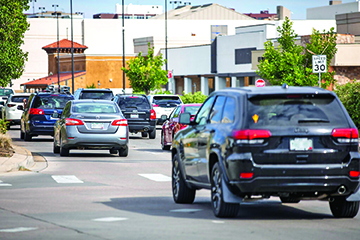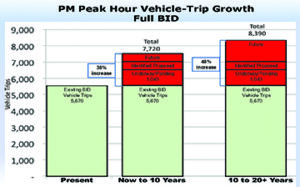District’s First Ever Data Driven Study Of BID’s Growth Exposes Rising Congestion, Slowing Business, And Declining Quality Of Life
by Glen Richardson

Creek Car Congestion: District’s growth has had biggest impact at 1st Ave. & University. New Cherry Creek West project will worsen traffic problem, BID’s data analysis forewarns. Photo by Kevin J. Beaty/Denverite
One of the most dynamic business and residential areas in the Mile High City, development in Cherry Creek North has exceeded the 10-year forecast. The attraction of businesses and their office space needs, moreover, is accelerating the desire of certain businesses to relocate to the district from other areas of the city.
With the impressive growth has come traffic congestion, parking, and transportation problems. The first ever data driven analysis of the Business Improvement District’s (BID) actual growth and development since 2012 has just been released. Study is being distributed to various RNO’s, neighborhood organizations, plus city agencies. Those with comments and concerns should contact their city councilman.
The analysis is the mastermind of retired longtime Cherry Creek resident volunteers David Steel, former President of Western Development Group; and Wayne New, former Denver District 10 City Councilman. The pair piloted the study because they care about the community and want to maintain the quality of life and success that all businesses and residents now enjoy. Furthermore, the business-residential leaders have more than 40 years of real estate experience in the U.S., Canada, and Europe.
Creek Data Analysis
 Cherry Creek North’s growth has had the greatest traffic effect on 1st Ave., University, and surrounding neighborhood streets. The
Cherry Creek North’s growth has had the greatest traffic effect on 1st Ave., University, and surrounding neighborhood streets. The
Steel-New data analysis of the district emphasizes that fact and is key to recommendations they are making. Bottom line: The more difficult it becomes to move around the district, the less appealing it will become.
Albeit the pending Cherry Creek West development is planned on Cherry Creek Shopping Center property, it will have a significant impact on 1st Ave. traffic and its efficient movement through Cherry Creek.
The proposed 1,918,170-sq.-ft. development will create the highest grouping of high-rise buildings in the Cherry Creek area. More important to 1st Ave., the seven-building development will create 1,922 vehicle trips during the evening (PM) peak hour. That’s at an intersection that has already reached its maximum vehicle capacity according to traffic standards.
Building Toward Gridlock

West End Traffic Trap: Despite being on Cherry Creek Shopping Center property, massive Cherry Creek West project will add to gridlock at the 1st Ave. & University intersection.
Cherry Creek West development vehicle trips will only add to the present 1st Ave. traffic movement problems. In addition, the East West Partner’s Large Development framework document estimates that 3,000 new jobs will be added, increasing the vehicle trip counts.
Using the 2013 national standard ratios to calculate Cherry Creek West vehicle trips per evening (PM) peak hour, the number of vehicle trips was determined to be 1,922 trips for all three building uses.
Three of the seven proposed buildings will be devoted to residential use and will be required to abide by the City’s affordable housing requirements, which would reserve 10% of the units for low to moderate income households. The framework description lists the residential buildings as having 598 units.
Project Cutback Proposed
To reduce the traffic impact from Cherry Creek West, the study recommends the following changes to the development plans:
Reduce the building heights from the proposed 12-13-stories to 8-stories, which would be consistent with Cherry Creek BID Zoning. Change the numbers of proposed office buildings from four to three, and change the number of proposed residential buildings from three to four.
Since community residential space is needed more due to the number of existing and new office space developments, new mixed-use development should emphasize residential use. Increasing the residential square-footage will have a dramatic reduction in traffic volumes generated by the project. The vehicle trip standard for office use is approximately three-times the standard for residential use, and the standard for retail use is five-times the level of residential traffic trips. An estimated 713 traffic trips per evening (PM) peak hour should assist in lessening the traffic impact on 1st Ave. and University.
Parking-Valet Service
Additionally, the study urges the continued support of Cherry Creek North’s BID Zoning. The pair say the 2014 rezoning process was a productive, cooperative process that greatly enhanced the previous BID zoning to allow and promote greater development within its boundaries. They emphasize, however, that it is important to recognize the rezoning requirement be maintained in order to minimize future growth and mobility problems.
Short term, the value of a BID Parking Benefit District should be studied. Such a district would tie the economic benefits of performance parking directly to improving the quality of life in the immediate area. Residents and businesses are more receptive to such a district as the revenues are reinvested in the neighborhood. Additionally, the value of a Parking Benefit District should be considered. They reduce traffic congestion while increasing local sales tax revenue.
With parking difficulties identified in Denver Moves Cherry Creek as a major problem, Steel and New also suggest a centralized BID area for a paid valet service should be organized and tested. It would provide a convenient one-stop spot for customers and residents using cars to park and shop in Cherry Creek. They also believe the 2013 Development & Traffic Study be maintained on a timely basis to project future growth and needs accurately. Lastly, they urge a professional planner-traffic engineer be engaged by BID to update the study.
Clayton-Sears Site

District Data Duo: First ever data driven analysis of BID’s growth was created by longtime resident volunteers. They are from left, David Steel, former President of Western Development Group, and Wayne New, former Denver District 10 City Councilman.
 The Clayton-Sears development — the other Cherry Creek west-end development about to begin construction — is also expected to impact 1st Ave. traffic.
The Clayton-Sears development — the other Cherry Creek west-end development about to begin construction — is also expected to impact 1st Ave. traffic.
The site will feature 126,000-sq.-ft. of new four-story buildings plus ground floor retail space. An 867,000-sq.-ft. eight-story apartment building with 25 residential condominiums is planned above the existing Clayton parking garage.
Vehicle trip counts and traffic flow for the Clayton-Sears development will also have impact on 1st Ave. traffic flow. The project, moreover, will impact traffic on 2nd Ave., Columbine Street, and Clayton Lane. Fortunately, a large percentage of the project is devoted to residential use which produces fewer vehicle trips than retail uses.
Intersection Gridlock
How busy is the University Blvd. and 1st Ave. intersection? The Denver Regional Council of Governments (DRCOG) says it averages more than 50,000 vehicles every day. Moreover, DRCOG says the stretch of University Blvd. just south of 1st Ave. tallies more than 45,000 cars daily.
Overwhelmed by the traffic, commuters driving through the intersection contacted Denver7 Traffic Expert Jayson Luber in Sept. of 2023. The intersection traffic was “driving them crazy,” they told the reporter who has been with Denver7 since 2006 and reported traffic for KOA Radio prior to that.
The intersection supports cars traveling in multiple directions, Luber was told by the Denver Department of Transportation & Infrastructure (DOTI). Cars going through the intersection are turning in multiple directions and must also provide time for people to safely cross on foot, all in about the span of two minutes. Moreover, they emphasized the two minutes is divvied up between all the different movements at the intersection. The morning light timing, the city told Luber, is designed to allow for more traffic to flow heading into downtown and prevent backups on University Blvd. and Speer Blvd. It is just the opposite in the afternoons, with more time allotted for eastbound traffic out of downtown.
Link Provided To View BID’s First Ever Data Driven Analysis
The Chronicle has provided a link to the full data driven analysis of BID’s actual growth and development since 2012. Titled “Reinvesting in the Future,” it is a progress Report and Analysis on Cherry Creek Growth, Development, Traffic, and Impacts on 1st Ave. View the study at: glendalecherrycreek.com/wp-content/uploads/2024/01/Cherry-Creek-Analy sis-1-8-24.pdf.
